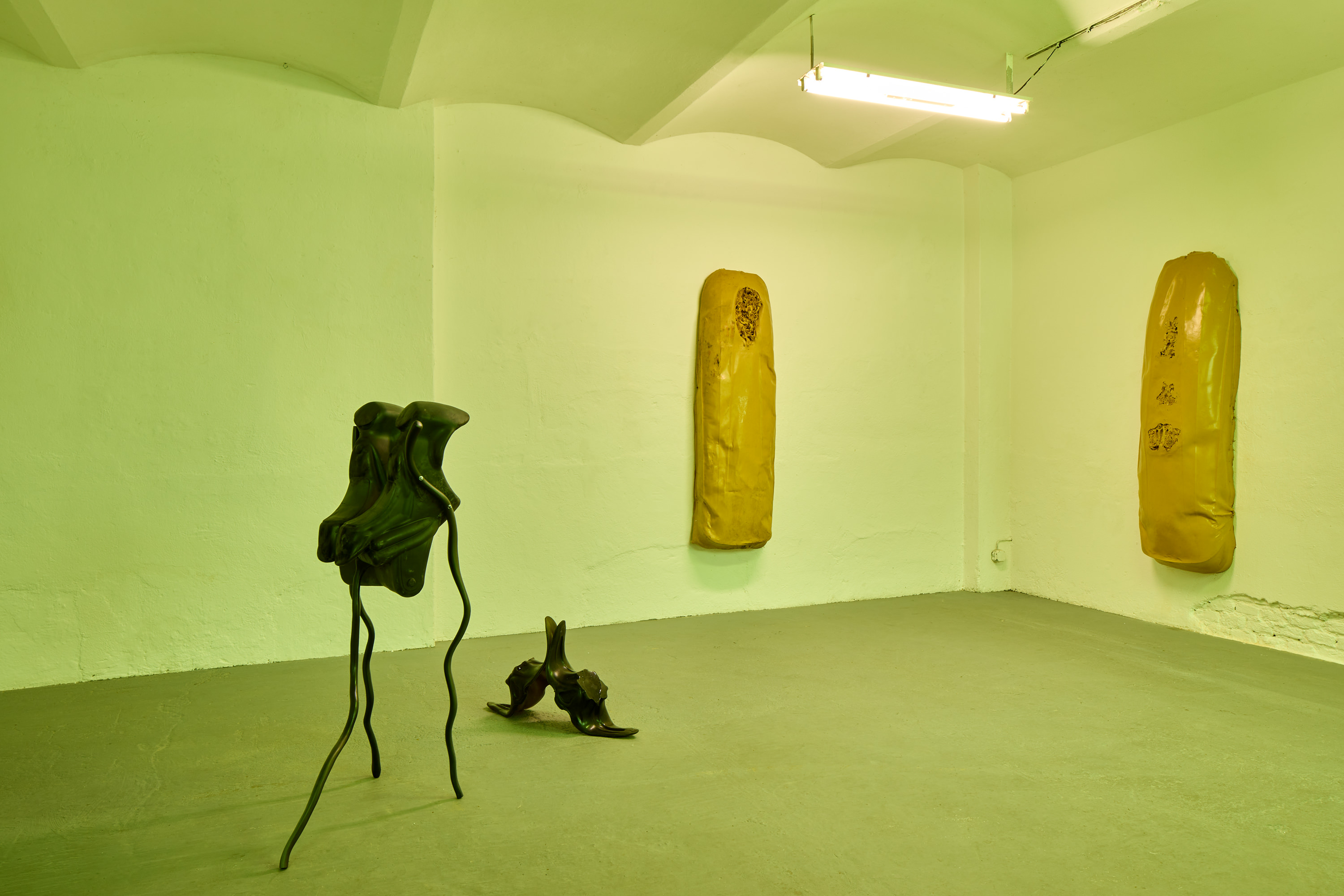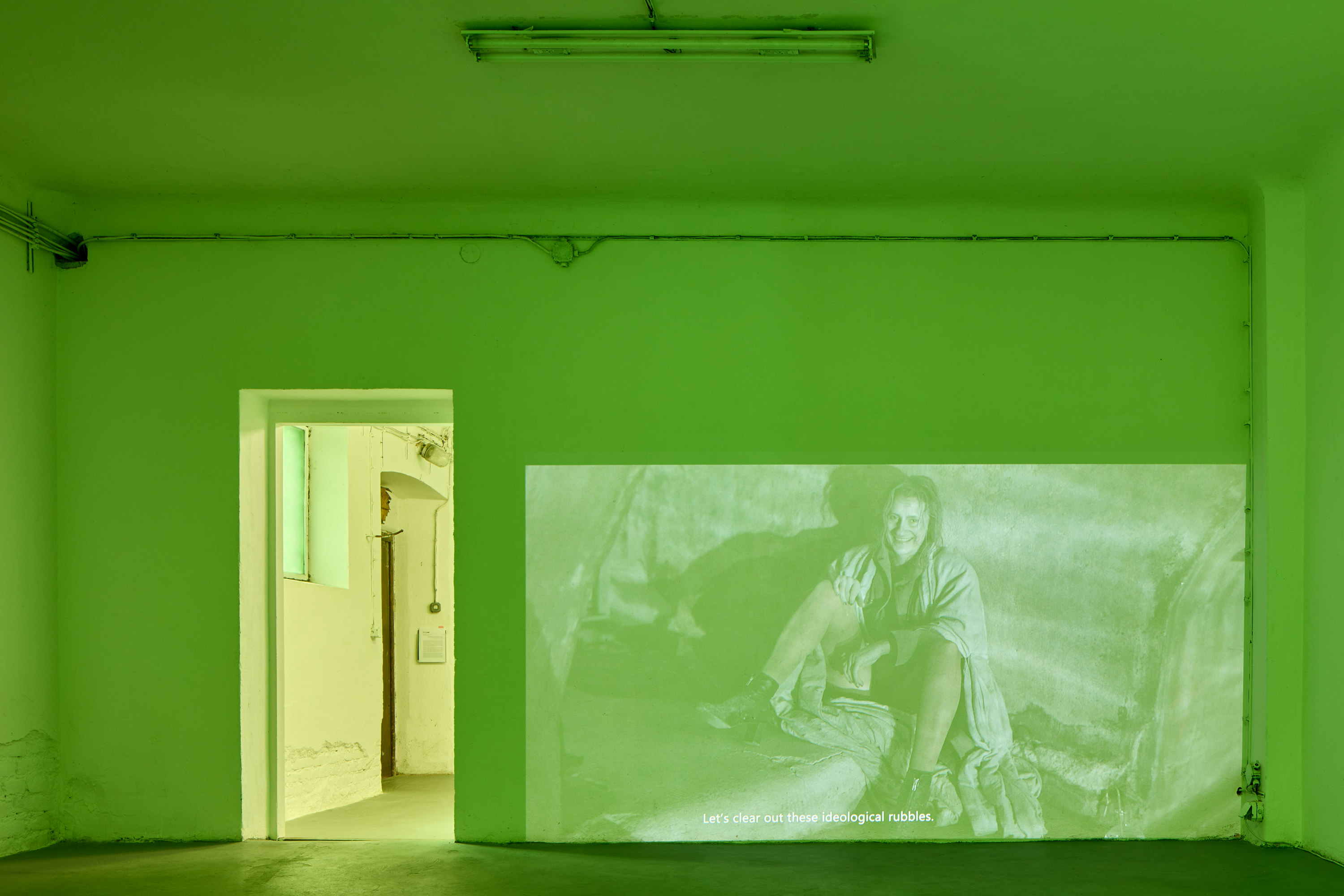Duo show w.
Šimon Chovan, 2023
Curated by Noemi Purkrábková & Jiří Sirucek at Šachta gallery, Prague (CZ)
Text by Noemi Purkrábková
Featured works :
Curated by Noemi Purkrábková & Jiří Sirucek at Šachta gallery, Prague (CZ)
Text by Noemi Purkrábková
Featured works :
︎ Foulplay video 2022-2023
No body of my own I, II sculptures 2022-2023

No body of my own Isculptures 2022-2023
Jesmonite, bended aluminum tubes, wood, 90 x 90 x 32 cm
︎Foulplay video 2022-2023
Video 4K, color, stereo sound, 12’


No body of my own IIsculptures 2022-2023
Jesmonite, bended aluminum tubes, wood, elastomer 160 x 160 x 58 cm
Some metamorphoses disrupt the snowball that one forms with oneself over lived time, that big round ball: full, replete, complete. These strange figures rise out of the wound, or out of nothing, an unhitching from what came before.
– Catherine Malabou, The Ontology of the Accident
In her book The Ontology of the Accident, French philosopher Catherine Malabou writes that “no one thinks spontaneously about a plastic art of destruction. Yet destruction too is formative. A smashedup face is still a face, a stump a limb, a traumatized psyche remains a psyche. Destruction has its own sculpting tools.” She reflects on the power of phenomena we commonly think of as disruptive – destruction, deviation, failure, trauma, discard, expiration, loss, crisis, aging, even death – yet are in fact constantly transforming the world. They alter the shape of bodies, objects, and ideas, which all prove to be unsettlingly malleable. The joint exhibition of Laura Gozlan and Šimon Chovan takes up these modeling tools of "destructive plasticity," testing through sculpture and moving image the integrity of bodies and the recognizability of (social) forms. Can we be sure of what we see and hear? Are we outside or within? Where lies the boundary between intimate and public? And what hides in the bowels beneath the rigid surface of the pavement?
Stepping into the landscape of “The New Wounded” might at first feel unsettling, as it does not open itself effortlessly, giving us a series of “nice” objects with polished surfaces. It does not promise a dreamy escape from the everyday, but rather forces us to kneel down and look closer, to squeeze in, sink in, and get dirty while trying. The exhibition thus asks the spectator to perform a symbolic lowering of a sort – a movement which leads us away from “great ideals” and bright futures, flooding the gallery space with a dense mess in which we can't trust the basic “truths'' we've been told. As Mum, the protagonist of Gozlan's video Foulplay hints, “it’s true there’s a treasure buried in the ground. But it’s not gold – it’s filth,” inviting us to descend into the dirty, the ignored, the low – the both real and abstract sewage of life, the inner body crawling with animating parasites, even as we confidently proclaim autonomy and uniqueness.
Submerged, we enter a murky zone in which the edges of former infrastructure disappear, and the silhouettes of things only hint at their possible shapes – a moment when the technological and organic fuse together while remaining distinct, offering a peek into a (perhaps already present) world where forms melt down and take up new meanings. The sculptural works in the exhibition embrace this ambivalence: they shift what seems familiar, sometimes allowing for a glimpse of resemblance or symmetry, and other times twisting it completely, covering up the contours of things until they turn strange, unrecognizable, alien. Chovan's glinting protrusions of steel swallowed by beeswax, the tubular shapes revealed by cuts in silicon molds, or the pipes and chassis of Gozlan's sculptures remind the viewer of the marriage between bodies and technology presented with absurd literacy in J. G. Ballard's Crash – the novel in which wounds famously functioned as openings into a new, technologically transformed era of human life. Likewise, we can recall William Burroughs' belief in the magical power of the cut, as he famously stated: “When you cut into the present, the future leaks out.” But we have known of our instrumentalization for a long time now – industrialized, bent and fucked over. It rarely surprises us anymore, and the increased hiddenness of this reality is matched only by the banality of its critiques. But now that future possibility is vanquished, what leaks out when we cut?
“The New Wounded” attempts to open these questions, embracing the infected, the unstable, the stupid, the cursed. Yet without praising a misogynistic, penetrative death-drive in which self-mutilation always holds hands with the destruction of the Other, we are rather interested in different sensitivity of the wound: that which departs not from the one who inflicts violence, but from the wounded, or from the wound itself. Here self-dissection poses a performative, even pleasurable possibility; far from the disfiguration wrought on bodies in a collision, it is a cut that runs deep into our common life and elicits a whimper. A cut that does not cut into the future but makes present what we can ignore no more. A cut that slices from the inside and lets in something alien. What “strange figures rise” out of such a wound remains a matter of uncertainty, of accident: “A form born of the accident, born by accident, a kind of accident. A funny breed.”
Noemi Purkrábková

